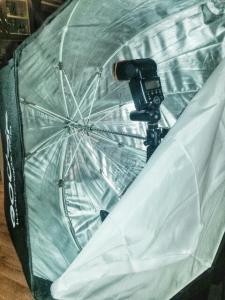A bare light, be it from flash or studio strobe, is very harsh and hard. It will create stark contrast and sharp shadows. For some applications this may be exactly what you want but often it is not – especially if you’re looking to produce some flattering portraits.
To soften the light you need some sort of modifier and there are many to choose from;
Umbrella – perhaps the most common, and used either with a reflective internal surface that reflects flash light back onto the subject or semi-opaque that allow you to shoot through the umbrella and diffuse the light. Another shoot-through option is the softbox
– a rectangular box with a semi-opaque cover on the front (and possible further diffusion material inside) which again diffuses light nicely.
Combining the two you get an umbrella box which opens like an umbrella and has a silver inside but also has the ability to fix a diffusion layer to the front like a softbox. Available in many sizes, these are very versatile yet collapse down small when not being used.
The items above can be large and not very portable so there are a range of smaller flash soft boxes to fix to a flash mounted on your camera. While not quite as effective as bigger umbrella boxes they are an improvement on bare flash and small enough to be portable – Glyn Dewis uses one for many of his black background portraits.
Another relatively new invention is the flash bender which can act like a reflector or a diffuser and even a snoot if you shape it correctly.
You can make the most of the light you have by using a reflector – this can be used to bounce natural light onto a subject or reflect flash light back. A 5-in-1 type comes with 4 different coloured surfaces – white, silver, gold and black – and can also act as a diffuser if you take off the cover completely.
One item that will really help you with flash photography is a light meter. This speeds up the setting up of shots massively and takes away all the guess work and trial and error. Simple ones measure incident light only – the light falling on the subject – so you would stand by the subject and test the light coming from your strobes directly. Other meters will also allow reflective light metering – which is what your camera does. Measuring the amount of light reflected back from the subject. A must-have for the serious flash user.
If you feel like getting creative with flash then some cheap flash gels will allow you to change the colour of the light that you produce. You may want to do this to match orange evening sun if you are shooting with ambient + flash light, or match the colour of tungsten lights if you’re shooting indoors. Or you might want to add a cool moody blue tint. Or you might be looking for something much more creative like purple or green light. Whatever the aim, a cheap set of gels for flashes are very handy.


